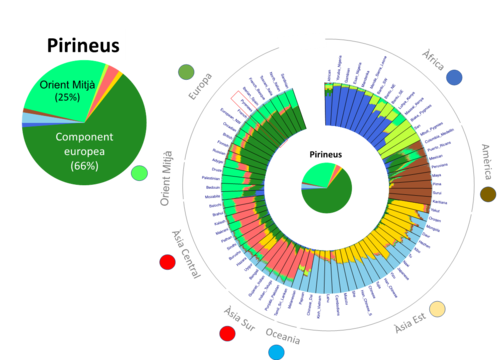Research led in Lleida will define the genetic risk profile of the population of the Catalan Pyrenees
It is a multi-centre study with the participation of the University of Barcelona, the National Centre for Genomic Analysis and hospitals in the Pyrenean counties
A study led by Lleida and the National Centre for Genomic Analysis (CNAG) has analysed the genetic diversity of the population of the Catalan Pyrenees. This research will define the genetic risk profile of the population of the Pyrenees to common diseases, providing a current and complete vision of the genetic susceptibility to pathologies such as cancer, coronary heart disease or diabetes, of great importance for a modern and effective management of public health programmes. The research is financially supported by the Public Health programme of the Diputació de Lleida.
The multicentre GenPIR research, led by Joan Fibla, head of the Genetics of Complex Diseases research group at the Biomedical Research Institute of Lleida (IRBLleida) and professor at the University of Lleida (UdL), with the participation of the University of Barcelona, the CNAG and the hospitals of the Pyrenean counties, already has the first results that indicate the genetic diversity of the population of this area, which has genetic components from both the Iberian Peninsula and Central Europe. The participating hospitals are the Hospital Sant Bernabé de Berga, the Fundació Hospital de Olot i Comarcal de la Garrotxa, the Hospital de Campdevànol-Hospital Comarcal del Ripollès, the Fundació Sant Hospital de la Seu d'Urgell and the Hospital Comarcal del Pallars.
This study was initiated in 2011 by the researcher Pedro Moral of the University of Barcelona, who, with the collaboration of several hospitals in the Pyrenean counties of Catalonia, collected epidemiological data and biological material from a total of 925 people living in the Pyrenean demarcations. In the current research, the research team has selected a total of 435 of these people whose parents and paternal and maternal grandparents were born in the Pyrenean regions, with whom the genetic characterisation of more than 8 million variable genome sites (genetic polymorphisms) has been carried out.
The genetic information obtained has been compared with the genetic data available from 3,936 individuals from 76 human populations from all over the world, which has allowed the genetic origin of the Pyrenean populations to be studied. The results indicate that this is a population with a heterogeneous genetic component from both the Iberian Peninsula and Central Europe, where geographical barriers have played a determining role in defining the genetic profiles of the population.
"The distribution of the genetic components of the European population shows a gradation from west to east of the Iberian component and a reverse gradation from east to west of the Central and Eastern European component, while the south-eastern component, coming from Italy-Sardinia, is equally distributed among all the regions. This can be interpreted as a reflection of a greater permeability of the eastern regions (Garrotxa-Ripollès) to contributions from Central Europe, while the western regions (Pallars-Alt Urgell) would have been more permeable to contacts with the peninsula," explained Fibla.
So far, most of the populations considered in population genetics studies in Europe are of urban origin or are poorly characterised geographically, representing large geographical or even continental regions. It is for this reason that the study of genetic variation in regions that present natural barriers, where populations can be very well characterised historically, and with particular demographic histories, represents an important piece of the puzzle of genetic variation in Europe.
The research is scheduled for completion in 2021 and the results will be submitted for publication.

Genetic profile of the Pyrenean population compared with the 76 world reference populations.






